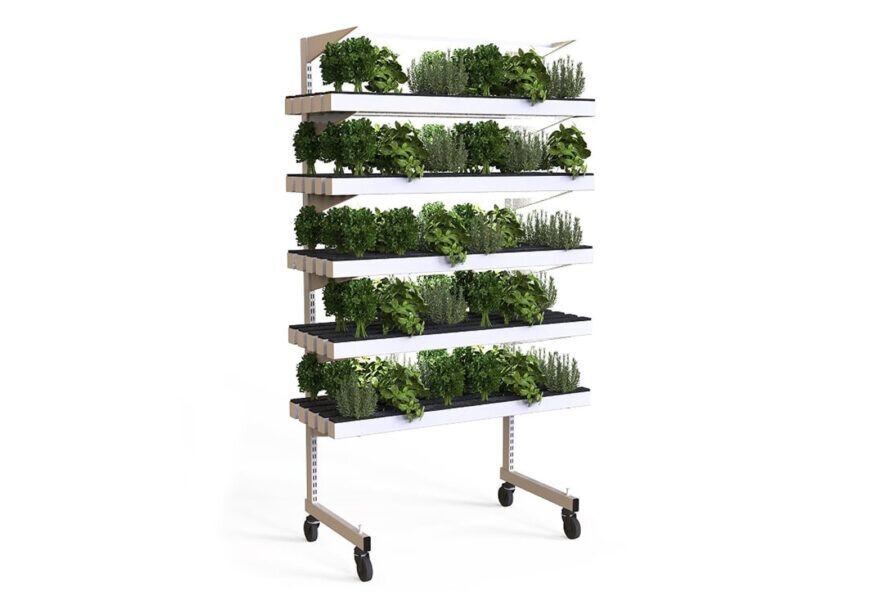
Welcome to iGrow News, Your Source for the World of Indoor Vertical Farming
HECTAR Offers Free Design Plans For Open Source Hydroponics Unit
Felix Wieberneit from the Royal College of Art and Imperial College London imagined a way for U.K. citizens with a limited amount of indoor space to build their own vertical garden and is now making the design free for anyone to download
Among all of the new hobbies picked up during the COVID-19 lockdowns, gardening has to be one of the most popular. Felix Wieberneit from the Royal College of Art and Imperial College London imagined a way for U.K. citizens with a limited amount of indoor space to build their own vertical garden and is now making the design free for anyone to download.
Described as an open-source hydroponics unit, the HECTAR vertical farm is designed especially for interiors to help more people grow healthy food from home. Sponsored by multinational technology company Huawei, the unit is inspired by open-source electronic and 3D printing companies. Open-source describes a type of computer software that’’s released under a special license made to be accessible to the public. HECTAR has since been selected as one of 25 companies in the Imperial College Venture Catalyst Accelerator, a competition for local entrepreneurs.
It looks like a simple shelf, but the innovative hydroponics unit can grow a whopping 120 plants confined to a space the size of a cupboard. Even better, the design is fully modular and can be built using standard parts found in almost any hardware store. Wieberneit hopes the free plans will educate and empower regular people to grow their own food at home, without relying on pricey smart growing systems or seed subscription services. In theory, the unit can save users money in the long run as they cultivate their own edible plants like arugula, lettuce or herbs.
Plans include an instructional video, a bill of materials, and suggestions on where to find the parts. There is also a dedicated forum where users can ask questions if they get stuck or connect with others. The plans officially launched on March 16, and the company is still looking for U.K.-based beta testers to try the designs out for themselves. Those who are interested can download the plans from the HECTAR website, linked below.
Canadian Aquaponics - Canada's Source For Aquaponic Information and News
Most aquaponic systems are single loop and fully recirculating. This means that the fish and plants exist in a single loop and share the same nutrient rich water
A place to learn and stay current with what's happening in the world of Aquaponics
TUESDAY, 18 JUNE 2019
Decoupled Aquaponics
Why Decoupled Aquaponics
Most aquaponic systems are single loop and fully recirculating. This means that the fish and plants exist in a single loop and share the same nutrient rich water. The reason these are the most popular is because they are simple to build and operate. But single loop systems are also a compromise because the plants, fish and bacteria must all be happy in the same solution. So for example, the temperature and pH levels must be maintained at levels that satisfy all the organisms, rather than being optimized for each.
pH is maintained in a range to satisfy fish, plants and bacteria in a single loop system
In a dual loop system, these parameters can be maintained optimally at different levels in each loop. Additionally, if something goes wrong, there are more options to address the situation without affecting everything in the system. So for example, if pests need to be treated on the plant side, it can be done without adversely affecting the fish.
How Decoupled Systems Work
A typical decoupled system consists of a stand-alone RAS (recirculating aquaculture system) loop and a hydroponic plant loop. The sludge from the RAS system is digested in the biological waste system which provides the nutrients for the hydroponic system. Using a digester makes the system more efficient because the nutrients plants need (aside from Nitrogen) are trapped in the solid waste. The aerobic digester (a fancy term for a simple tank with air-stones in it) mineralizes the solid waste, releasing the nutrients the plants need.
A Simple Decoupled System
A small decoupled system can be very easy to build and operate. If an AST bead filter is used, the fish loop is reduced to two components (fish tank and bead filter) because bead filter combines both bio-filtration and very efficient mechanical filtration. It also makes the system very easy to maintain and operate because it is self-cleaning. The following video shows simple the decoupled system can be with an AST bead filter.
The Heart of the System: AST Polygeyser Bead Filter
Although the video above shows a smaller endurance filter, the AST Polygeyser 3 cubic foot automatic backwash bead filter can be used to build a similar system that supports up to 60 m2 of plant area (900 gallon fish tank with up to 4.5 pounds of feed per day input).
Posted by JustAquaponics.ca at 20:28 Email ThisBlogThis!Share to TwitterShare to FacebookShare to Pinterest
Labels: Best Practices, Decoupled Aquaponics, Education, Mineralization, Reference










